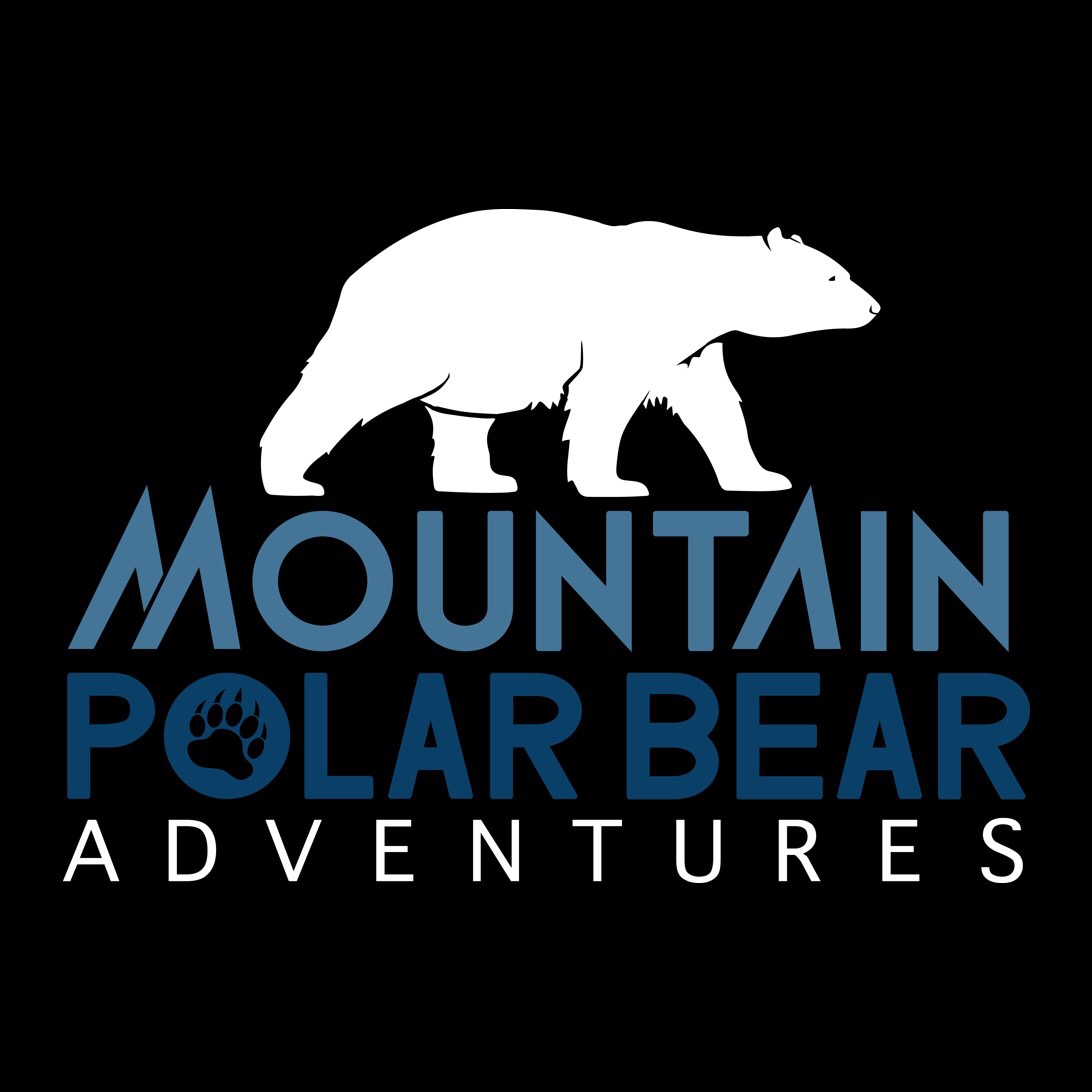Nine days have passed since my last update here. During this time we have been up on the mountain again twice, trying to reach camp 2 at 6200 metres.
Our first attempt we started the 3rd of July at three o’clock in the morning. We knew that several other teams were going up to camp 1 the same day, so we wanted to be out early. We reached camp 1 at nine o’clock. That was one hour faster than the first time.
We enjoyed the lunch bag our cook Ali had packed for us as a second breakfast. Then we tried to sleep a bit, but the sun was directly on our tents, so it was extremely hot. It was also very crowded in camp – every single one of the few tent spots were taken.
During the afternoon it became more windy and started to snow. Unfortunately, this kind of weather continued the whole night. At 4 AM, Ryan called base camp on the radio and asked our high altitude porter Fida, who was supposed to join us, not to come up. When we woke up around six, the weather hadn’t changed, so Ryan and Tomás decided that it was safer to go down. So unfortunately we didn’t reach camp 2 as planned this time.
On Wednesday, the 6th of July, we started our second attempt at 3:30 AM. It took us five hours and twenty minutes to camp 1 this time, which was another forty minutes faster than the last time. It started snowing during our climb and got chilly, so my fingers were a bit cold. But apart from that, everything went fine. We were the only ones at camp 1 this time, so this was much nicer than the last time.
Ironically, when we woke up the next morning at four or five o’clock, it was stormy outside again and snowing. We talked to Fida at base camp on the radio. He was supposed to come up, but due to the weather he stayed down. For us it seemed that we either had to stay an extra day at camp 1 (which we hadn’t planned food for, but we had plenty of snacks) or return to base camp another time without reaching camp 2.
But first we waited and slept a bit longer. Fortunately, around seven o’clock, the weather was a bit better. So we decided to continue to camp 2 after all and see how far we would get. We left camp 1 at 9:30. The route to camp 1 goes between rocks most of the time up to the main ridge we will be climbing on. We climbed partly on rock, but mostly on snow or ice. Some sections were very steep, so it was hard work.
We had quite calm weather in the beginning, but the wind got stronger again during the day. As we reached camp 2 at around 1:30, it was really stormy outside, so we had problems setting up our tents on the ridge. I was very relieved when I could finally move into our tent and warm myself up.
In the morning, we woke up at four o’clock. There was a beautiful sunrise above K2 outside. It was also ice cold, so even in the tent I got cold fingers when I started packing my backpack. This got worse when we eventually left the tent, so things like putting crampons on were quite a challenge.
We started walking around 5:30. The way down to camp 1 was quite easy and rather short. We reached camp 1 at a quarter past seven.Here we repacked some of our stuff. Sleeping bags and some more equipment stayed here, so that we continued down to ABC (advanced base camp) with almost empty packs.
Directly below camp 1 on the rocky part, we met our high altitude porter Fida who was on his way to camp 1 with some oxygen bottles. He joined us again shortly after on our descent.
We reached ABC already at nine o’clock – setting a new time record for the descent with one hour and twenty minutes. And after a short break here, we continued towards base camp which we reached around 10:30. Our liaison officer, captain Mohsin, the cooks Ali and Golam, and Akhbar were already waiting for us here with some snacks.
Now we are ready for the final rotation on the mountain. We need a window of five days with good weather – four days up and one day down. That might start in the beginning of next week after a couple of rest days here. But we have seen the weather change very quickly before. So we will have to be patient.
Category Archives: Uncategorized
First visit to camp 1
Hello again from Broad Peak Base Camp!
We have successfully finished our first visit on the mountain. We got up early at three o’clock two days ago so that we could leave base camp at four in the morning. This way we would have rather hard snow which is easier to climb on, and the risk of rockfall is smaller.
After some rest days at base camp, it was great to finally start climbing. The climb up to camp 1 was mostly on steep snow slopes and a few places where we climbed on rock (which is the most fun part, maybe). The whole route was perfectly prepared with fixed lines by our guides so that we could safely climb even the steeper slopes (45-50 degrees).
It took us about seven hours to reach camp 1 at 5600 metres. Here we stayed for two days and two nights so that our bodies could get the maximum effect out of the stay at a higher altitude.
The descent back to base camp today went much faster. It took us only two hours to get back to “advanced base camp” – a spot at the foot of the mountain which we use for storing some of our climbing gear – and another 45 minutes back to base camp.
On our way down from camp 1 we met another team consisting of two Spanish guys, an American and a Dane. It seems like they won’t be of much help, though, fixing so we either have to wait for other teams to arrive, or our guides will have more hard work ahead of them fixing the route between camp 1 and 2 which still includes some very steep slopes.
Our whole team is now back at base camp relaxing. Everybody is feeling well, and we are looking forward to some rest here and then our next rotation on the mountain, starting hopefully in a couple of days.the remaining part of the route, so we either have to wait for other teams to arrive, or our guides will have more hard work ahead of them fixing the route between camp 1 and 2 which still includes some very steep slopes.
Our whole team is now back at base camp relaxing. Everybody is feeling well, and we are looking forward to some rest here and then our next rotation on the mountain, starting hopefully in a couple of days.
Hello from Broad Peak Base Camp!
After a long hike (six days incl. one rest day) has our team reached Base Camp. We stood up at 5 AM every day in order to avoid the worst heat in the afternoon. There were many other groups on the trail, which are either trekking groups or climbing groups.
Most of the trekking groups hike to Concordia which we passed today. It’s a place where three big glaciers meet and from where you can see several 8000 metre peaks. These groups either trek back the same way or over a different pass (the Gondogoro La).
Most of the climbing groups have K2 as their goal. Some go to Gasherbrum 1/2 Base Camp, while we are so far the only group at Broad Peak. We know there will be a few more coming though.
Base Camp is located on a big glacier, but there are rocks on top, so we are not directly on snow or ice. We have a great dome tent here – with a carpet floor, heater and music. So I believe we’ll have a good time here for the coming weeks. Tomorrow will be a rest day, and I’m looking forward to a late morning in my sleeping bag.
Next stop: Skardu
After another long bus ride, we have reached the town Skardu. During our ride we passed Nanga Parbat, the 9th highest mountain in the world at 8126 metres (also known in German as “Schicksalsberg der Deutschen”). This is the area where the Hindukush, the Karakoram and the Himalaya mountain ranges meet.
After a short photo break we continued to Skardu. In the late afternoon, we already had a chance to take a walk through town. The Balti people who live here are very friendly and apparently more used to tourists than in the conservative regions we passed through yesterday. In Skardu we will stay for two nights. Tomorrow will be a rest day/packing day before we continue to the last outpost of civilisation, Askole, the day after.

The team: Benedicte, Gaute, Ryan, Mr. Nansen, Tomás, myself and Ajaz

On our way to Skardu

Downtown Skardu
Quick check-in from Chilās
After a long 15 hours’ bus ride, we have arrived in Chilās – a small town in a region called Kohistan. We left at 3 AM this morning. The first few hours, the road was pretty good, but later it become more bumpy. We saw fascinating towns and villages on the way. Unfortunately, we could not stop and take any pictures in most of the places, but we’ll get a chance for that tomorrow.
Hello from Islamabad

Our team enjoying a delicious dinner at Restaurant Kabul
Salaam alaikum!
We have reached our first stop, Islamabad. I arrived here early this morning at 4 AM, checked into our hotel and got a few hours of sleep before I met the rest of the team at breakfast.
The guides had to do some paperwork for the authorities today while the rest of us could go to a supermarket or just hang out at the hotel. In the evening we had a nice Afghani dinner at Restaurant Kabul. It’s Ramadan at the moment, and it seems like the streets are much more busy with people in the evening than during daytime when it’s also almost 40 degrees Celsius outside.
Tomorrow we have to get up very early again. We will leave the hotel at 3 AM and have a 15-16 hours’ drive along the Karakoram Highway to Chilas in the Gilgit-Baltistan region in Northern Pakistan. From there we will continue on Monday towards Skardu which will be the last bigger town before we og further north to Askole in the Central Karakoram National Park from where we will start our hike into Base Camp.
I’ll check in again from Skardu.
P.S.: For those of you who have been following my attempt to order a new sleeping bag and get it delivered to Oslo – on Thursday (one day before departure) I got the message that it was in Oslo now, but only ready to be picked up the next day. Unfortunately, my flight left at 11:15, so I had to leave to the airport without my new sleeping bag and with another (thinner) one instead. At 9:15 while I was queing for check-in, I got the message that it now was ready for pick-up in my local store in Oslo. So I called my good friend Petra who drove to the store, picked up the parcel and came to the airport where I could receive my new sleeping bag at 10:50, i.e. 25 minutes before departure. Then I was denied to use the fast track at the security check (!), but I made it anyway through the security check, running through the whole airport to the non-Schengen-gates, through the passport control and to my departure gate. Now I’ve got a sleeping bag with 1250 grams of down instead of 750 which will keep me warm at Base Camp. Thank you, Petra!!
Up and down and up and down
Many people wonder why climbing a big mountain takes such a long time. Well, firstly, many high mountains are in remote areas which are difficult to reach by car, by plane or other means of transport. In our case we use the first six days of our tour to get to our starting point Askole in North Pakistan.
Secondly, the trek into base camp can take some time – in our case another six days. This trek also helps the body to slowly acclimatise to higher altitudes. It produces more red blood cells so that the blood can transport oxygen better and compensate for the lower air pressure in higher altitudes. This is important in order to avoid high altitude sickness.
Finally, the climbing of the mountain itself takes a long time. As a rule of thumb, one should only move 300 metres higher per day so that the body can adapt. In practice, this means that we need carry days and rest days before we can move further up the mountain. On a carry day, we climb up to the next camp, leave some equipment, food or gas there, and return down to our last camp to sleep there. This is called the “climb high, sleep low” principle, which helps your body to acclimatize to greater altitudes. Rest days make sure that your body can recreate after a long hike or climb, possibly with heavy loads. They also serve as buffer for bad weather, so in reality rest days are often not planned, but occur when bad weather stops us from continuing our ascent.
In the picture below, I have made a draft what our expedition could look like. This schedule will be adapted on our way, but it shows as an example how often you actually climb up and down before you finally have the chance to reach the summit.
Stay tuned for further updates on mountainpolarbear.com! Departure in t minus 9 days.
Change of plans – new destination: Broad Peak
Some time ago, I wrote in my blog that I would try to climb Gasherbrum 2 this year – my first peak over 8000 metres. After some back and forth, we finally changed the mountain we are going to climb. Now it’s going to be Broad Peak. Broad Peak is the 12th highest mountain on earth at 8051 metres. It is also located in the Karakorum mountain range, right between Gasherbrum 2 and K2 in Northern Pakistan at the border to China.
I’m climbing with Mountain Professionals again. The team consists of two Norwegians, myself and our guides: expedition leader Ryan Waters from the US and lead mountain guide Tomas Ceppi from Argentina. In addition we will have local staff who assist us on our expedition.
I will leave to Pakistan on the 10th of June, and the expedition will take seven weeks in total – roughly one week to finalise some details, get climbing permits and drive from Islamabad to North Pakistan where we will start our trek. The hike into base camp, which is located at an altitude of approximately 5000 metres, takes six days. From there we have approximately four weeks to try to climb the mountain, and finally another week to hike out and get back to Islamabad.
More updates coming here soon.
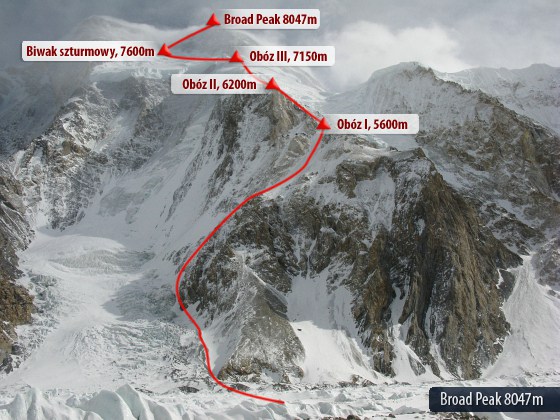
New logo, new facebook page, new Instagram account
Today, I’d like to proudly present an upgraded social media profile of Mountain Polar Bear Adventures.
First of all, I’ve got a new logo – designed by my gifted colleague Turid. We’ve been working on this for a while, and I’m extremely happy with the result. Hope you like it, too.
Secondly, I’ve created a facebook page for all Mountain Polar Bear activities.
And finally, there is a new Instagram account where I will post expedition, travel, training or outdoor photos.
I’ve also got a new expedition planned for the summer. News coming up on these channels soon, so feel free to follow! :-)
Aconcagua recap
After about two weeks in the Andean mountains we are back in Mendoza, Argentina, where we started our expedition to Aconcagua, the highest peak in South America.
We started our trip with a three days’ hike up to the Plaza Argentina base camp at 4200 meters. This was the easiest part for us because mules carried most of our baggage. We even had one river crossing on the back of mules which was fun. Above base camp, there were three more camps before we could try to reach the summit. At camp 2 (5400 m) we were stuck for four nights because of a storm that brought quite a bit of snow, before we could move on to camp 3 at 5900 m.
At 5 AM Monday morning we left the camp and started the ascent to the summit, wearing our headlamps in a cold night. The way to the summit was pretty long and tough. The snow was knee-deep, and although our guide Chhering did a fabulous job breaking the trail for us, I was very exhausted the further up we came. At 2 PM we finally reached the summit and were rewarded with a stunning 360 degrees view and hardly any clouds.
The way back down to our camp took us three and a half hours. The next day we descended to base camp Plaza de Mulas on the other side of the mountain and were lucky to get a helicopter flight out to the trailhead instead of hiking out the next day.
Now we are enjoying the Argentinian summer and cuisine in Mendoza. I stay here until tomorrow, then I’ll spend a couple of days in Buenos Aires before I return to Norway on Saturday.
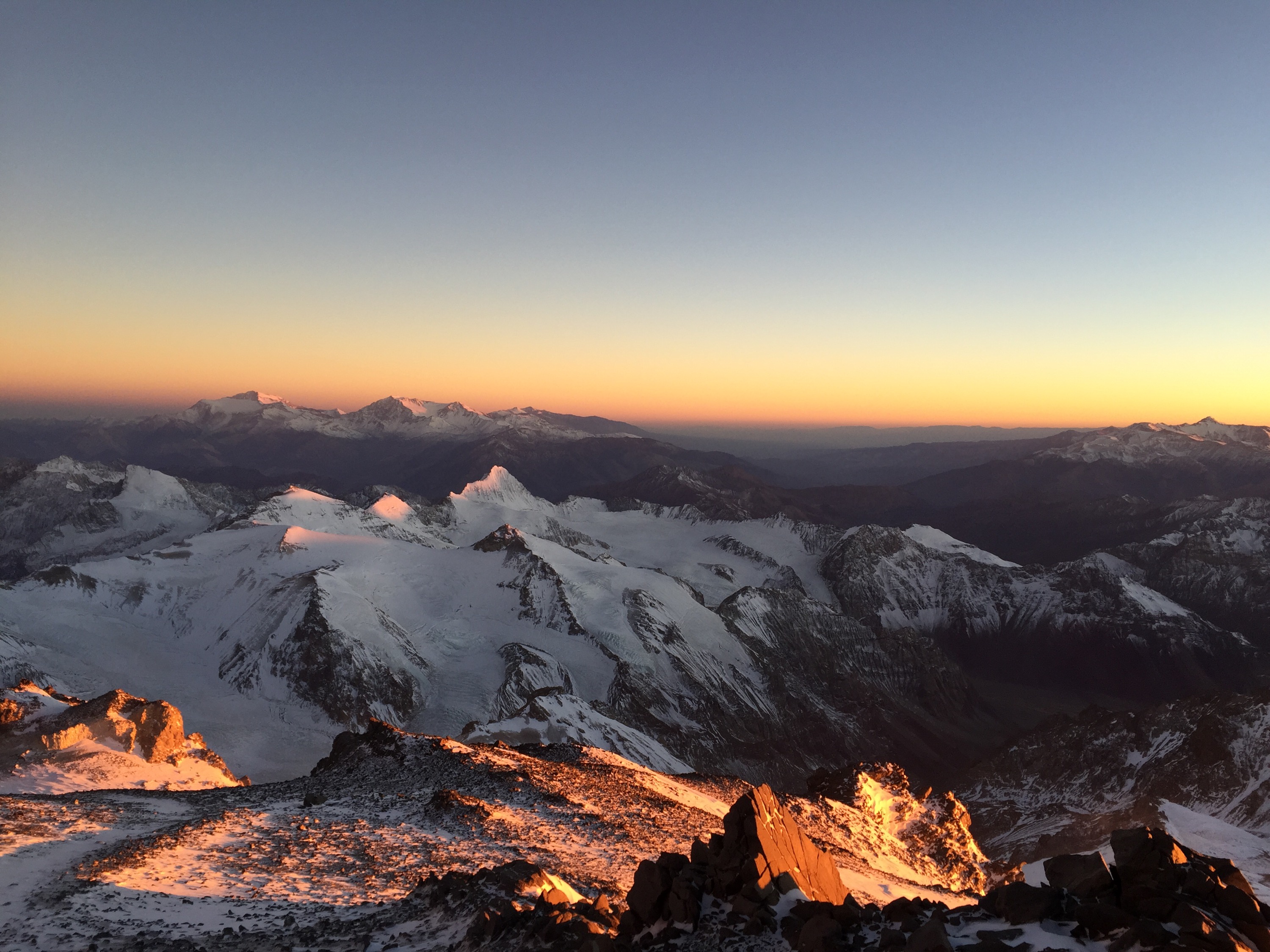
Mountain panorama on summit day right after sunrise Mules – our trusted partners on the way to base camp
Mules – our trusted partners on the way to base camp
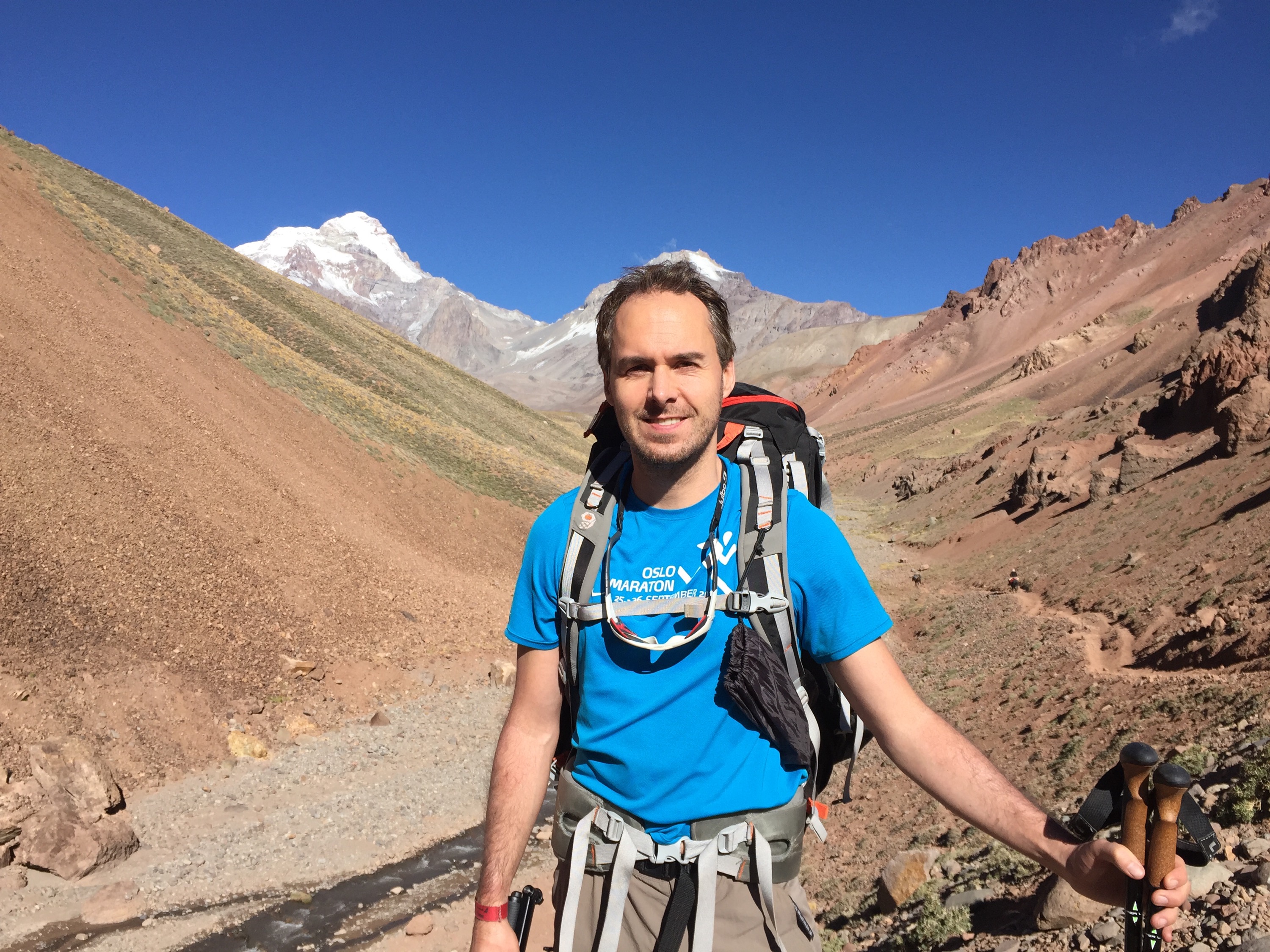 Day 3 on the way to base camp – Aconcagua in the background
Day 3 on the way to base camp – Aconcagua in the background
 Sunrise on summit day
Sunrise on summit day View from camp 2 after the storm
View from camp 2 after the storm
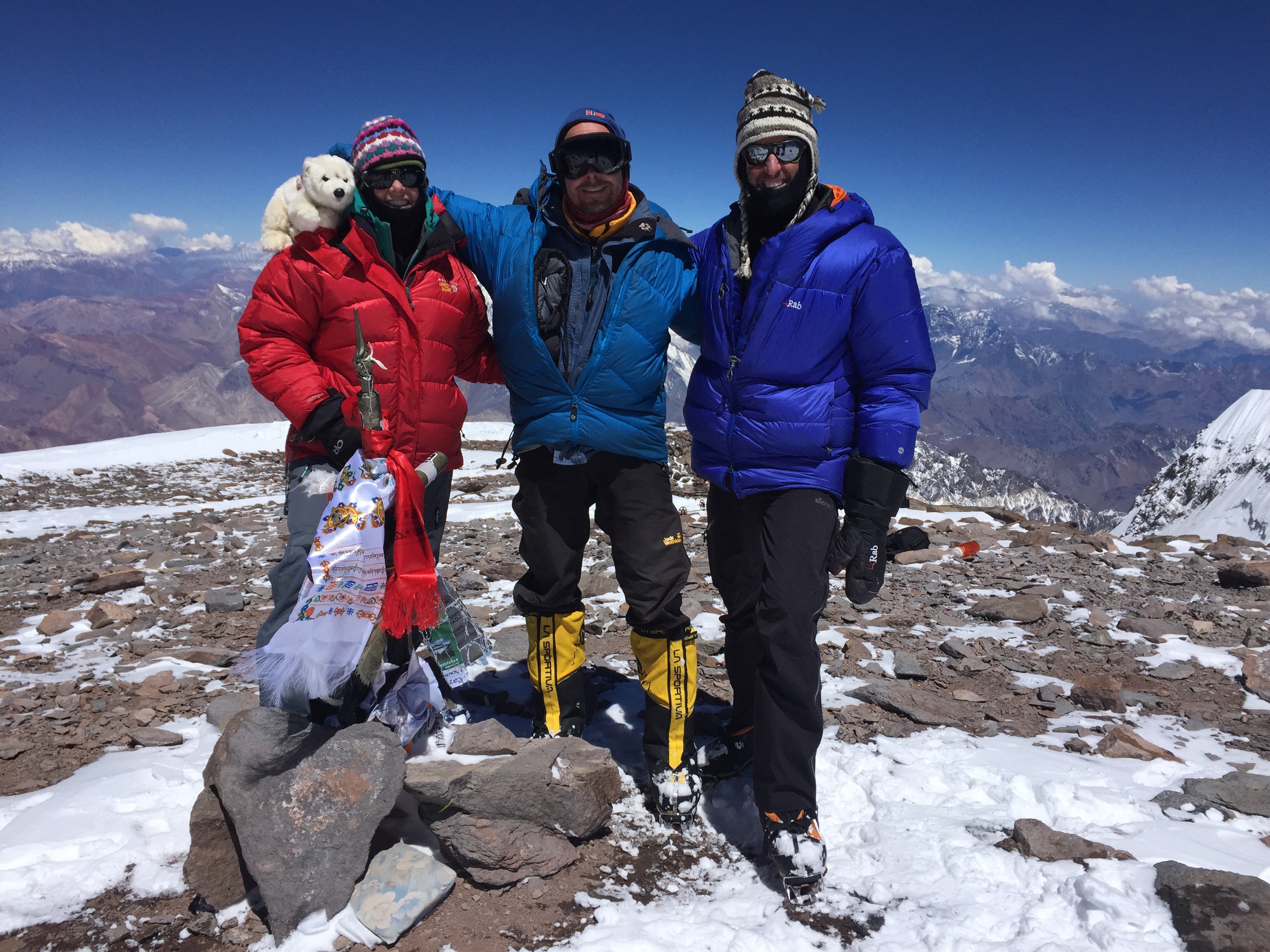 Summited (from left to right): Mr. Nansen, Jodi, Stephan and Richard
Summited (from left to right): Mr. Nansen, Jodi, Stephan and Richard
 Descent from high camp to base camp
Descent from high camp to base camp
 Short break with guides Ryan (left) and Chhering (right)
Short break with guides Ryan (left) and Chhering (right)






